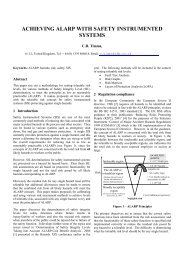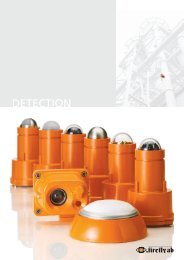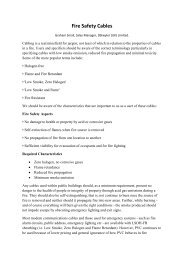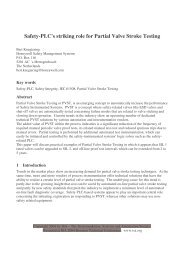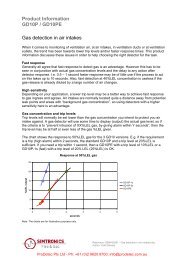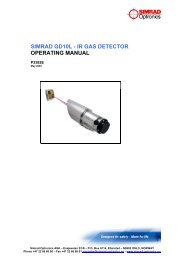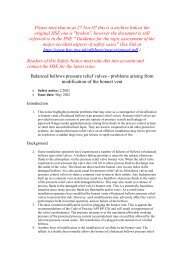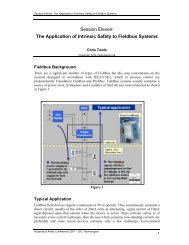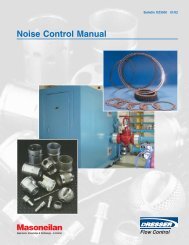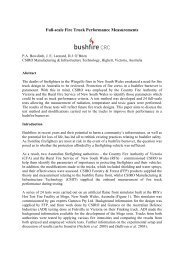The effect of temperature gradients on ultrasonic flow ... - ICEWeb
The effect of temperature gradients on ultrasonic flow ... - ICEWeb
The effect of temperature gradients on ultrasonic flow ... - ICEWeb
Create successful ePaper yourself
Turn your PDF publications into a flip-book with our unique Google optimized e-Paper software.
<str<strong>on</strong>g>The</str<strong>on</strong>g>ory<str<strong>on</strong>g>The</str<strong>on</strong>g> principal working <str<strong>on</strong>g>of</str<strong>on</strong>g> the ultras<strong>on</strong>ic <strong>flow</strong>-meter is simple. Sound signals are generated bya set <str<strong>on</strong>g>of</str<strong>on</strong>g> pizo-acoustic elements and sent in opposite directi<strong>on</strong>s with and against the <strong>flow</strong>directi<strong>on</strong>. <str<strong>on</strong>g>The</str<strong>on</strong>g> difference in travel time between the two signals is used to determine the <strong>flow</strong>velocity (v measured ):vmeasuredL 1 2 tdown1tWith L being the distance between the transducers, and t up and t down are the up- and downstream travel times. Figure 2 shows a sketch <str<strong>on</strong>g>of</str<strong>on</strong>g> the measurement principle.upFigure 2: Flow velocity measurement.Figure 3 shows a sketch <str<strong>on</strong>g>of</str<strong>on</strong>g> the <strong>flow</strong> meter. <str<strong>on</strong>g>The</str<strong>on</strong>g> sensors are placed at a certain distance Y*from the center plane in order to produce a measurement result which is the closest possiblerepresentati<strong>on</strong> <str<strong>on</strong>g>of</str<strong>on</strong>g> the average velocity (v average ).vaverageQA1AAvdAWith Q being the volume <strong>flow</strong> rate and A is the cross secti<strong>on</strong> area <str<strong>on</strong>g>of</str<strong>on</strong>g> the tube. <str<strong>on</strong>g>The</str<strong>on</strong>g> <strong>flow</strong>velocity pr<str<strong>on</strong>g>of</str<strong>on</strong>g>ile will change with average <strong>flow</strong> velocity and it is not possible to obtain anexact measurement <str<strong>on</strong>g>of</str<strong>on</strong>g> the average velocity over the entire velocity range, a linearity errorwill be present:vmeasurederror 1vaverage<str<strong>on</strong>g>The</str<strong>on</strong>g> linearity error is measured for each sensor before leaving the factory. When no<str<strong>on</strong>g>temperature</str<strong>on</strong>g> <str<strong>on</strong>g>gradients</str<strong>on</strong>g> are present the media viscosity can be assumed c<strong>on</strong>stant and the <strong>flow</strong>velocity pr<str<strong>on</strong>g>of</str<strong>on</strong>g>ile may be derived from Navier-Stokes equati<strong>on</strong> for c<strong>on</strong>stant viscosity. <str<strong>on</strong>g>The</str<strong>on</strong>g>presence <str<strong>on</strong>g>of</str<strong>on</strong>g> a <str<strong>on</strong>g>temperature</str<strong>on</strong>g> gradient will destroy the ideal situati<strong>on</strong> because the liquidproperties will become a functi<strong>on</strong> <str<strong>on</strong>g>of</str<strong>on</strong>g> positi<strong>on</strong>. Because <str<strong>on</strong>g>of</str<strong>on</strong>g> this, an error is introduced but itssize and variati<strong>on</strong> with <strong>flow</strong> velocity is so far not clear.
Figure 3: Sketch <str<strong>on</strong>g>of</str<strong>on</strong>g> the <strong>flow</strong> meter.Problem formulati<strong>on</strong>It seems appropriate to start with an analysis <str<strong>on</strong>g>of</str<strong>on</strong>g> the relatively simple situati<strong>on</strong> where no<str<strong>on</strong>g>temperature</str<strong>on</strong>g> <str<strong>on</strong>g>gradients</str<strong>on</strong>g> are present and then afterwards try to implement them, this will givea clearer picture <str<strong>on</strong>g>of</str<strong>on</strong>g> the differences between the two situati<strong>on</strong>s.T internal T ambientAt first, axis-symmetric fully developed <strong>flow</strong> is assumed and <str<strong>on</strong>g>temperature</str<strong>on</strong>g> <str<strong>on</strong>g>effect</str<strong>on</strong>g>s areignored.v v(r)v x 0 c<strong>on</strong>st .xDeduct the expressi<strong>on</strong>s for the <strong>flow</strong> velocity pr<str<strong>on</strong>g>of</str<strong>on</strong>g>iles, for fully developed <strong>flow</strong> intubes, in both the laminar and the turbulent case - or even better, a general expressi<strong>on</strong>for both cases.Determine if there is an optimum radial positi<strong>on</strong> Y * in which the relative axial <strong>flow</strong>velocity (v/v av ) does not change with average velocity and find an expressi<strong>on</strong> forthis.Find an expressi<strong>on</strong> for the sensor linearity error in the optimum point.




